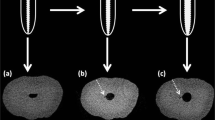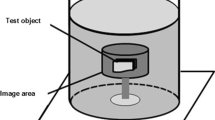Abstract
The aim of this study was to use high-resolution micro-CT to evaluate the effects of three Ni–Ti rotary endodontic instruments, Mtwo® (VDW, München, Germany), ProTaper® (Dentsply-Maillefer, Ballaigues, Switzerland) and Revo-S™ (MicroMega, Besançon, France), on canal transportation and centring ratio. Fifty-four mesial roots of extracted mandibular molars with an angle of curvature of 25–35° were randomly divided into three groups of eighteen. Each group was instrumented with a previously unused Ni–Ti rotary system. The final instruments used were #30/0.05 taper (Mtwo®), F3 #30/0.09 apical taper (ProTaper®) and AS30 #30/0.06 taper (Revo-S™). Teeth were scanned before and after instrumentation using micro-computed tomography with a spatial resolution of 20 μm to measure volume and shaping changes. All images were filtered to improve signal-to-noise ratio. To determine the perimeter of roots and canals exactly, images were segmented in each slice with an edge detection process. Canal transportation and centring ratio were evaluated at 1, 3, 5 and 7 mm from the end of each root. The method developed by Gambill et al. was chosen. ANOVA was conducted with the significance threshold set at p < 0.05. No statistically significant differences were found among the three groups in terms of canal transportation or centring ratio at any level. These systems give similar results with regard to the tested shaping parameters. Under the tested conditions and within the limitations of this study, these systems were able to produce centred preparations of curved canals with minimal transportation.


Similar content being viewed by others
References
Walia H, Brantley W, Gerstein H. An initial investigation of the bending and torsional properties of a Nitinol root canal files. J Endod. 1988;14:346–51.
Haapasalo M, Shen Y. Evolution of nickel–titanium instruments from past to future. Endod Topics. 2013;29:3–17.
Pruett JP, Clement DJ, Carnes DL Jr. Cyclic fatigue testing of nickel–titanium endodontic instruments. J Endod. 1997;23:77–85.
Peters OA. Current challenges and concepts in the preparation of root canal systems: a review. J Endod. 2004;30:559–67.
Plotino G, Testarelli L, Al-Sudani D, Pongione G, Grande NM, Gambarini G. Fatigue resistance of rotary instruments manufactured usinf different nickel–titanium alloys: a comparative study. Odontology. 2014;102:31–5.
American Association of Endodontists. Glossary of endodontic terms. 7th ed. Chicago: AAE; 2003.
Schäfer E, Bürklein S. Impact of nickel–titanium of the root canal on clinical outcomes: a focused review. Odontology. 2012;100:130–6.
McSpadden JT. Mastering endodontic instrumentation. Chattanooga: Cloudland Institute; 2007.
Peters OA, Schonenberger K, Laib A. Effects of four Ni–Ti preparation techniques on root canal geometry assessed by micro computed tomography. Int Endod J. 2001;34:221–30.
Freire LG, Gavini G, Sanches-Cunha R, Dos Santos M. Assessing apical transportation in curved canals: comparison between cross-sections and micro-computed tomography. Braz Oral Res. 2012;2:222–7.
Shen Y, Cheung G. Methods and models to study nickel–titanium instruments. Endod Topics. 2013;29:18–41.
Schneider SW. A comparison of canal preparations in straight and curved root canals. Oral Surg Oral Med Oral Pathol Oral Radiol Endod. 1971;32:271–5.
Gambill JM, Alder M, del Rio CE. Comparison of nickel–titanium and stainless steel hand-file instrumentation using computed tomography. J Endod. 1996;22:369–75.
Stern S, Patel S, Foschi F, Sherriff M, Mannocci F. Changes in centring and shaping ability using three nickel–titanium instrumentation techniques analysed by micro-computed tomography. Int Endod J. 2012;45:514–23.
Aguiar CM, Sobrinho PB, Teles F, Câmara AC, de Figueiredo AP. Comparison of the centring ability of the ProTaper™ and ProTaper Universal™ rotary systems for preparing curved root canals. Aust Endod J. 2013;39:25–30.
Weine FS. Endodontic therapy. 5th ed. St Louis: Mosby Co; 2006.
Gergi R, Abou R, Jeily J, Sader J, Naaman A. Comparison of canal transportation and centering ability of Twisted files, Pathfile-ProTaper system and stainless steel hand K-files by using computed tomography. J Endod. 2010;36:904–7.
Peters OA, Laib A, Gohring TN, Barbakow F. Changes in root canal geometry after preparation assessed by high resolution computed tomography. J Endod. 2001;27:1–6.
Paqué F, Zehnder M, De-Deus G. Microtomography-based comparison of reciprocating single-file F2 ProTaper technique versus rotary full sequence. J Endod. 2011;37:1394–7.
Hashem A, Ghoneim A, Lutfy R, Foda M, Fatah Omar G. Geometric analysis of root canals prepared by four rotary Ni–Ti Shaping Systems. J Endod. 2012;38:996–1000.
Basrani B, Roth K, Sas G, Kishen A, Peters OA. Torsional profiles of new and used Revo-S Rotary Instruments: an in vitro study. J Endod. 2011;37:989–92.
Diemer F, Michetti J, Mallet JP, Piquet R. Effect of asymmetry on the behavior of prototype rotary triple helix root canal. J Endod. 2013;39:829–32.
Yang G, Yuan G, Yun X, Zhiu X, Liu B, Wu H. Effects of two nickel–titanium instrument systems, Mtwo versus ProTaper Universal, on root canal geometry assessed by micro-computed tomography. J Endod. 2011;37:1412–6.
Celik D, Tasdemir T, Er K. Comparative study of six rotary nickel–titanium systems and hand instrumentation for root canal preparation in severely curved root canals of extracted teeth. J Endod. 2013;39:278–82.
Schäfer E, Erler M, Dammaschke T. Comparative study on the shaping ability and cleaning efficiency of rotary Mtwo instrument. Part 2. Cleaning effectiveness and shaping ability severely curved root canals of extracted teeth. Int Endod J. 2006;39:203–12.
Plotino G, Grande NM, Falanga A, DiGiuseppe IL, Lamorgese V, Somma F. Dentine removal in the coronal portion of root canals following two preparation techniques. Int Endod J. 2007;40:852–8.
Soontag D, Ott M, Kook K, Stachniss V. Root canal preparation with the Ni–Ti systems K3, Mtwo and ProTaper. Aust Endod J. 2007;33:73–81.
Elsherief SM, Zayet MK, Hamouda IM. Cone-beam computed tomography analysis of curved root canals after mechanical preparation with three nickel–titanium rotary instruments. J Biomed Res. 2013;27:326–35.
Arbab-Chirani R, Chevalier V, Arbab-Chirani S, Calloch S. Comparative analysis of torsional and bending behaviour through finite-element models of 5 Ni–Ti endodontic instrument. Oral Surg Oral Med Oral Pathol Oral Radiol Endod. 2011;111:115–21.
Conflict of interest
The authors declare that they have no conflict of interest.
Author information
Authors and Affiliations
Corresponding author
Rights and permissions
About this article
Cite this article
Vallaeys, K., Chevalier, V. & Arbab-Chirani, R. Comparative analysis of canal transportation and centring ability of three Ni–Ti rotary endodontic systems: Protaper®, MTwo® and Revo-S™, assessed by micro-computed tomography. Odontology 104, 83–88 (2016). https://doi.org/10.1007/s10266-014-0176-z
Received:
Accepted:
Published:
Issue Date:
DOI: https://doi.org/10.1007/s10266-014-0176-z




